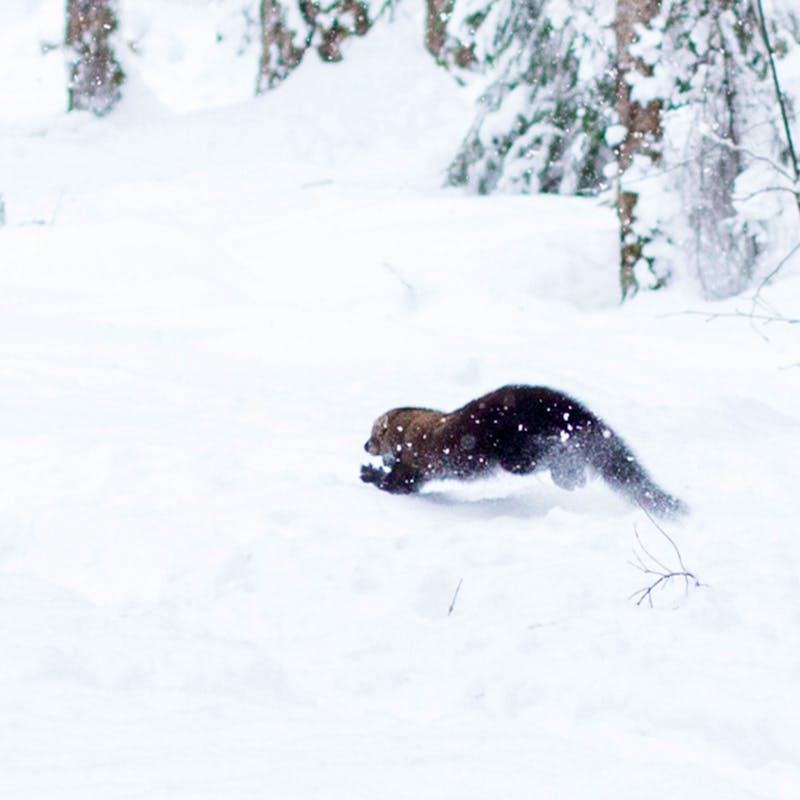Fence Repairs Promote Coexistence in Mexican Gray Wolf Country
When I awoke on an early November weekend in a campground twelve miles north of Reserve, New Mexico, in the heart of Mexican gray wolf country, my tent was coated with a thick layer of frost. It had been a cold night’s sleep, and as I crawled out of my sleeping bag, I could see that others in the campground were already busy packing their things and trying to stay warm. Summer had long passed, taking with it comfortable camping weather, but that wasn’t going to deter our volunteer group.
Despite the less than comfortable conditions, 15 volunteers, representing a diverse range of environmental organizations including Defenders of Wildlife, WildEarth Guardians and Southwest Environmental Center, had gathered that weekend from all over the state to repair barbed-wire fences on the Deep Creek grazing allotment – a 44-square mile area north of the Gila Wilderness. Far from any major town, we camped on an allotment that WildEarth Guardians had purchased the rights to the previous year with the intention of retiring it in order to recover the range and to decrease the chances that wolves that have denned in the area, like the Dark Canyon pack, would come into conflict with grazing cattle. The Alpha male and female of the Dark Canyon pack were the first to successfully rear cross-fostered pups to bolster the genetic diversity of the wild wolf population, and they also produced pups this year.
Since wolves were reintroduced in the area in 1998, they have sparked some controversy because of their potential to affect cattle ranching. Through our coexistence program, we work with ranchers to implement tools and techniques to reduce conflicts between wolves and livestock, which helps build acceptance for this ecologically important species. Earlier this year we supported WildEarth Guardians’ purchase of the grazing permit to help create a conflict-free zone for the valuable Dark Canyon wolves. Because of its rugged and steep terrain, the Deep Creek allotment provides excellent wolf habitat, but those same characteristics make ranching difficult in this area. The fences that separate the Deep Creek Allotment from the neighboring allotments will discourage cattle from wandering into this important part of the Dark Canyon pack’s territory. That’s where we volunteers came in.
[slideshow_deploy id=’30554′]
After packing our things, everyone regrouped in Reserve before caravanning thirty miles up a slow, twisty, pot-holed road to the worksite on the northern border of the Deep Creek allotment. We split up into our work groups and spread out along the three-mile fence line, which had been damaged in various spots due to trees falling, elk busting through and hunters cutting the fence line. To make sure that cattle could not wander into the allotment, the fence, which wolves can easily pass through needed to be repaired. One group of volunteers, students from New Mexico State University, hiked two miles west along the fence line to the furthest break. After splicing the break, they worked back towards camp, while another group slowly worked towards them, mending another break and removing fallen trees. A third group hiked for a mile, east along the fence, bailing discarded wire that had been left and cutting more trees. The final group of us followed behind replacing wood stays to help stabilize the fence.
We talked as we leapfrogged each other along the fence line. Some of the volunteers I had met before, and others I was meeting for the first time. As much as I enjoy meeting and speaking with our activists at local meet-ups, rallies, agency meetings and over the phone, I have always liked it best when we are outside working alongside one another. Not only do we get know each other better, but as volunteers, people become more invested in the issues and the places that we work on. These volunteers all cared about wolves before helping to repair the fence. But after spending hours working with their two hands, sweating, freezing and getting dirty to create a safer place for wolves, I know they are that much more invested in helping to protect and recover our lobos.
After we finished our repairs for the day, we sat around a campfire and reflected on the day’s activities. I spoke about Defenders’ work to promote coexistence, and Madeleine Carey of WildEarth Guardians spoke more on the group’s grazing allotment retirement program. We also talked about our fieldwork, the hikes we had done and places we had visited in wolf country to continue promoting coexistence. By the end of the evening, it was clear to me that the volunteers were not only wholly dedicated to the recovery of wolves, but on a personal level, I felt as if I knew all of them to a degree that time indoors could never match.
Defenders of Wildlife has long worked in wolf country with the goal of helping land owners live alongside wildlife. To do this, we have tried to keep wolves and cattle as separate as possible to decrease the chances of depredations on those herds. Thanks to the hard work of our volunteers, if the Dark Canyon pack chooses to den in the Deep Creek area again this spring, they will do so without livestock in the area, and without the risk of being killed or relocated because of them.




